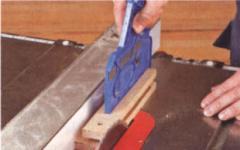In the task "how to determine the angle of the roof" there are a lot of unknowns.
You can find a solution for each of them in this article.
It is not for professionals. It is for those who are ready or have already taken up the development of the difficult profession of a builder.
All he needs is the ability to finance a future project and the enthusiasm of a pioneer in a new business.
The rest will be discussed later.
The roof is not only a beautiful element of a house under construction.
This is his long and comfortable existence.
Warm, cozy and dry building long years- the main motto of a good roof.
Before choosing one or another roof structure, its future owner considers a lot.
There are many of them and they all have strong arguments in favor of their existence:
- Flat roofs with a slope angle up to 3 0 . Widely used in typical civil and industrial construction. They require complex engineering system storm sewer. Regular snow and debris removal is required.
- Pitched structures are practical and functional. Depending on the selected angle of inclination, they are self-cleaning. Provides the opportunity to use the under-roof space in various purposes. However, they are complex and expensive to manufacture. The cost of repairing them is high.
In turn, pitched roofs can be both non-attic (mansard) and attic:
- For the attic option, their further purpose is very important - with or without operation.
- For the attic - it will be broken or simple. With a broken version, it becomes necessary, in some way, to "beat" the internal props.
The same structures can be single-sided and double-sided. Knowing how to determine the angle of the roof in degrees, it will be possible to apply modern ones. And also, in the most optimal way to use the under-roof space, without compromising the load-bearing characteristics of the structure:
- The hip option is one of the most practical and sustainable. In this case, 2 trapezoids and 2 pediment triangles are connected into one ridge. When erecting, professional experience and sufficient carpentry skill will be required.
- Half hip option - when gable triangles gable roof are split into 2 parts. Each of these parts is at a certain angle to each other. With complicated installation and increased costs, there are no additional benefits other than an aesthetic impression.
- The tent version of the hip roof - all the slopes converge at one, the highest point. More design than functional option. Good for houses that have a square or a regular, beautiful polygon in plan. It is aesthetically pleasing and has good strength characteristics.
- Multi-gable roof construction - most often used for buildings with a complex polygon shape in plan. It is characterized by a complex system of rafters and high cost. Accurate calculation and good project emphasize the individuality of the building.
- Dome and cone roofs are rarely used types of roofs. It is possible to use them in the form design solutions in the construction of complex compositions.
They block only some parts of the building under construction - arches, entrances to, turrets.
Combined options for all of the above designs. This is the most complex, beautiful and expensive roof. With a complex weir system, it is impractical to operate and difficult to repair.
What is a good roof? This is, first of all, a solid construction, high thermal protection and reliable resistance to atmospheric precipitation. If she is also beautiful at the same time, then the work is done well.
Slope angle dependent value
Most of the newly erected buildings have their own unique features. It might be unique modern design the entire dacha ensemble, excellent weather conditions.
In accordance with them, developed architectural project main building. At the same time, the roof plays an important role in shaping the overall impression of the complex being built.
Introductory concepts for a beginner roofer

When designing a roof ensemble, the starting point for all strength calculations is the angle of inclination "α" of its slopes.
This angle is usually measured in degrees during design and as a percentage - at.
It is located between the ramp itself and its horizontal projection.
For a flat roof, it is close to 0 0, for a conical one it exceeds 45 0.
The percentage of the angle α is the ratio of the height of the pediment to the horizontal projection of the slope and multiplied by 100.
This indicator is convenient to use directly during construction, almost by eye. Without Bradis tables, calculators or smartphones.
Since the width of the house is a known value, then multiplying it by half by the percentage of the slope, we get the pediment. The Pythagorean theorem will allow you to calculate the size of the rafters.
In this case, there is no need to use trigonometric formulas, as with degree indicators. Some relationships between percentages and angles are also well remembered - 45 0 is 100%, and 30 0 is 57.7 0.
In other words, 1% is 27′. The height of the pediment (legs) against an angle of 30 0 is equal to half the rafters (hypotenuse).
In practice, builders rarely use such calculations. More often, ordinary twine is used.
In the middle of the pediment, a long rail is nailed (strictly perpendicular). One end of the twine is fixed on the edge of the pediment, and the free end is raised to the required height along the installed rail.
The angle chosen in this way is measured with a goniometer or a template is made. Having made a notch on the rail, they get a ridge for retaining racks.
Influence of external factors
Knowledge of how to determine the angle of inclination of the roof by eye will not be worth anything, if you do not have an idea about the working conditions of the roof under construction. Any change in them will immediately lead to the recalculation of "α". The most basic of them are:
- Functional purpose of the roofing zone. If this zone will be used as a dwelling, then the angle of inclination is chosen from the largest of the acceptable options, based on strength calculations. IN otherwise use a variant with a broken structure. If it is an ordinary attic, then “α” should not be made more than 25 0.
- wind load. With prevailing moderate winds (up to 15 m / s), a slope of up to 45 0 will be quite appropriate. If squall gusts of strong winds are possible (more than 20 m / s), then one should not go beyond 25 0. In any case, a map of wind pressure zones should be used for information. Depending on the zone (from 1a to 5) of the location of the future building, the design of the roof should also be chosen.
- Precipitation. Using the map of snow pressure zones (8 zones with a load from 120 to 480 kg / m 2), you should compare the slope angle of the selected load, taking into account the correction factor. With "α" up to 25 0, the zone snow load remains unchanged (coefficient - 1). With its values from 25 0 to 60 0, the coefficient is 0.7. If "α" is more than 60 0, then the snow load is not taken into account.
- Materials of the top layer of the roofing "pie". With a slope angle "α" up to 15 0, the deposited rolled material, laid in 2 layers, works well. With "α" up to 5 0, the number of layers should be increased to 3. Tiles and ordinary slate work well in the range from 20 0 to 45 0.
A correctly chosen angle not only optimizes all the listed loads, but also in combination with roofing material provide reliable protection Houses.
Fundamentals of calculating the angle of inclination
One day, all procedures for identifying harmful factors affecting the durability, stability and water resistance of the future roof will end.
The loads are determined, the future purpose of the under-roof space is selected, the future purpose is assigned. It remains to calculate the angle "α" slope slopes:
- Wind load, in accordance with the map of wind pressure zones for the construction area, with gusts of not more than 15 m/s, allows the use of the angle "α" up to 45 0
- Snow pressure, in the 5th climatic zone, is 320 kg / m 2. For tilt angles up to 45 0, a reduction factor of 0.75 applies, which gives a result of a specific load of 240 kg/m 2 . Such a load will later be used to calculate the pitch and section of the rafters.
The angle "α" = 45 0, with a house width of 9 m and a ceiling height of 2 m, allows you to get a vertical section free space, under the gable, equal to 5.5 m 2. At the same time, the height of the ridge is close to 5 m.
By reducing the angle "α" to 35 0, the useful area will decrease to 3.5 m 2, which is quite acceptable. But at the same time, the height of the ridge will decrease to 3.5 m and significantly - the windage of the structure, cost, maintenance costs.
As a cover material, for a roof with a slope of 35 0, slate, painted in accordance with the taste of the owner, will be the most democratic.
At the same time, it should be noted that with such an angle of inclination, even more modern materials. For example, a metal tile can be laid starting from α = 10 0, but the joints must be sealed. It will also require an increased overlap.
Tiles of various compositions begin to be used at an angle of more than 20 0. The only thing that should be taken into account in this case is its not small weight. The last remark somewhat limits its application. But the service life is admirable - more than 60 years.
Flexible bitumen will leave few people indifferent. Both in form and color design it is suitable for any roof structure. At an angle α ≥ 18 0 does not require additional waterproofing in the form of a lining layer.
But rolled bituminous material is not suitable for the selected angle. This is especially true of the southern side of the slope. At high temperatures she might just slip away.
We carry out the calculation of the rafter leg
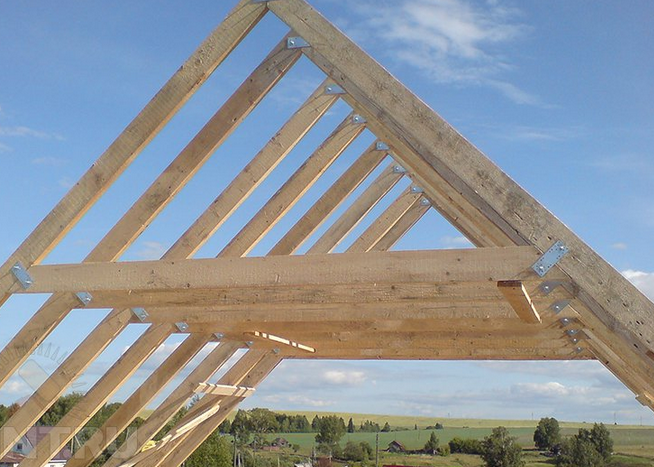
According to the course elementary school, the hypotenuse (rafter leg) is equal to the leg (half the width of the pediment) multiplied by cos α.
Or in mathematical form - L \u003d l / 2: cos α.
Substituting the available data, we get L = 9/2: cos 35 0 = 4.5: 0.819152044 = 5.5 m.
Similarly, or using the Pythagorean theorem, the height of the ridge racks can also be determined.
This . With its help, you can design reliable and durable structures.
But this is the prerogative of experienced designers. For beginner builders, it is important to have an idea about it and the ability to use it.
Noticed an error? Select it and click Ctrl+Enter to let us know.
Depending on the type of roofing material used, the angle of inclination of the roof is selected. To quickly remove water from the roof slopes, the designer needs to accept a certain slope. This important parameter can be expressed either by the ratio of the legs, you probably met the designation like ½ or 1/3, they can also be expressed using percentages. Next, we will discuss in more detail how to calculate the angle of the roof and select it for certain materials.
Roof slope and roofing materials
For device pitched roofs may apply various materials, which determine the slope angle. The most common are: asbestos-cement sheets, pulp-bitumen (these two are also called slate), soft tiles(other names - bituminous, shingles), roofing material, metal tiles, ceramic, cement tiles, etc.
The smallest roof slope is considered the most economical, since the hypotenuse is always longer than its legs. Therefore, the task of determining the minimum angle of inclination of the roof often arises. The tighter the joints of the material, the denser it is, the smaller the slope can be applied. If it has sealed joints, then the wind will not blow moisture under them. If the material is dense enough, then it will withstand heavy loads from precipitation, so it can be placed more hollow.
At the top, you are provided with a graph where blue lines indicate roof slopes with certain roofing materials. To determine what are the maximum and minimum slopes have certain materials, use the table below. Immediately, we note that the slope shows the angle of inclination of the slope with respect to the horizon. It can be large, then the roof will be called steep or small, then the roof will be called flat. As already written above, the slope of the slopes can be expressed in dimensionless quantities or in the form of degrees and percentages. It is most convenient to use dimensionless quantities, since only a tape measure is needed for this. If for some reason the carpenters do not know the height of the ridge, they can calculate it themselves. To do this, they measure the distance between the supports, that is, they find out the length of the span, find the middle and measure up half (with a slope of 1/1), a third (with a slope of 1/3) or another value.
The semi-circular scale shows the ratio in degrees, and the vertical one in percent. You can use this graph as a basis to calculate the minimum angle of the roof of the house. The bold line indicates a slope of 50%. Please note that the vertical segment h, acting as the ridge of the house, is placed in another larger leg twice. Note that the angle of inclination of the hypotenuse, that is, the roof of the house, is represented by the ratio of height to its location.
i \u003d height h / (1/2) \u003d 2.5 / (12 / 2) \u003d 5 / 12, or in other words 5: 12. To represent this slope as a percentage, this ratio must be multiplied by 100. We get the expression: 5:12*100 = 41.6666%. As we can see, 41.666% is the minimum roof slope.
Maximum and minimum roof slope angles of different roofing materials
The table is based on normative documents and practical experience. Remember that the market building materials are constantly updated, along with it, the possible angles of attachment of materials and their load bearing capacity. Thus, when choosing a specific roofing material, check with the manufacturer for its installation rules or use the attached instructions, if any.
| roofing material | Minimum roof pitch | Max roof pitch | |||||
| Weight 1 m^(2), kg | Aspect Ratio | In percentages | In degrees | Aspect Ratio | In percentages | In degrees | |
|
slate roof corner asbestos-cement sheets of medium profile |
11 | 1/10 | 10% | 6° | 1/2 | 50% | 27° |
| reinforced profile asbestos-cement sheets | 13 | 1/5 | 20% | 11.5° | 1/1 | 100% | 45° |
| cellulose-bitumen corrugated sheets | 6 | 1/10 | 10% | 6° | and more | ||
| soft, flexible, shingles, shingle | 9–15 | 1/10 | 10% | 6° | and more | ||
| galvanized sheet with single seams | 3–6,5 | 1/4 | 25% | 14° | and more | ||
| tin roof corner - galvanized sheet with double seams | 3–6,5 | 1/5 | 20% | 11.5° | and more | ||
| corner roof tiles | 50–60 | 1/5 | 20% | 11.5° | 1/0,5 | 200% | 64° |
| cement tile roof corner | 45–70 | 1/5 | 20% | 11.5° | 1/0,5 | 200% | 64° |
| metal roof corner | 5 | 1/5 | 20% | 11.5° | and more | ||
To skillfully convert from percentages to degrees, you can use the conversion table using the table below.

The tables located at the top allow you to quickly navigate in slopes expressed in percentages and degrees, as well as determine the minimum and maximum values of roof slopes. Let me remind you that the angle of inclination of roofs is different for most roofing materials and depends on the strength characteristics, because the materials have to withstand considerable loads and, in addition, remove the required amount of precipitation.
How to calculate the height with a known angle of inclination of the roof

How to find the height of the skate at home? To do this, you need to remember a simple formula: half the span is multiplied by the relative value shown in the image below. For example, if the width of the span of the house is 12 m, and the required slope is 30 degrees, then the height of the ridge will be: 12/2 * 0.59 = 3.54 (0.59, since according to the plate below this value must be taken for the angle of the roof at 30 degrees).
Roof of the house
The roof is a structural element of the building, which is responsible for its protection from external factors. It must successfully withstand atmospheric precipitation in the form of rain, hail, snow, heavy winds and destructive hurricanes. The correct slope of the roof plays a big role in the rapid removal of water and snow from the roof. In combination with high-quality waterproofing, it provides excellent protection for the entire structure, including the interior.
Not only these indicators, but also its long-term operation and strength will depend on a competent roof slope. How to make the calculation correctly, what factors to take into account, how to calculate it for roofs with different coatings - all these issues will be covered in this article.
On the factors affecting the calculation of the angle of the roof slope
Roofs, as already mentioned on our website, have different shape and the number of slopes. They are single, double and quadruple. The slope of the roof depends on the number of slopes on your house.
Calculation of the angle of inclination of the roof can be done using special building matrices and graphs, or you can simply use a square.
Construction work on the installation of the roof can be suspended if you do not decide in advance what material you are going to make the finish coating from and what angle of the roof. It must be remembered that these two concepts are closely intertwined, since the type of roofing material offered will be taken into account when calculating the angle of inclination of any pitched roof.
Let us dwell on the factors that are taken into account when calculating the angle of the roof.
For example, choosing the angle of inclination shed roof within 9-20 degrees, you will need to take into account factors such as
- finishing material;
- existing climatic conditions;
- functional purpose of the building.
In the case when the roof will have two or more slopes, then not only the above factors and the area in which the house will be built will be taken into account. It will be necessary to take into account the purposes for which attic space. If it is provided not for housing, but should be used to store temporarily unused things and objects, then you should not arrange a large room for these purposes (we are talking about the height of the ceiling). When the owners plan to make a living space in the form of an attic out of the attic, then there is a need for a good roof with a significant slope.
In those regions where strong winds are not uncommon, a minimal roof slope is made. Therefore, it does not have such a strong effect of the wind. It is also not recommended to make roofs without a slope. Such coatings can be arranged in regions with a large number of sunny days and a low probability of precipitation.
Wind resistance with a high roof is much greater than with a low one. However, with a very small slope, there is a possibility that the wind can tear off the finish coating. It turns out that with very steep roofs there is the same danger as with roofs that do not have a slope at all. Therefore, it is recommended to choose the following roof slopes - in case of weak winds, it can have a value of 35 to 40 degrees, in case of strong winds optimal angle roof slope is 15-25 degrees.
In areas where there is a lot of precipitation (we are talking about snowfalls, hail and rain), the angle of inclination can be increased to 60 degrees. It is the most suitable, because it allows you to minimize the load on the roof from snow cover, as well as melt water and a large number moisture during rain.
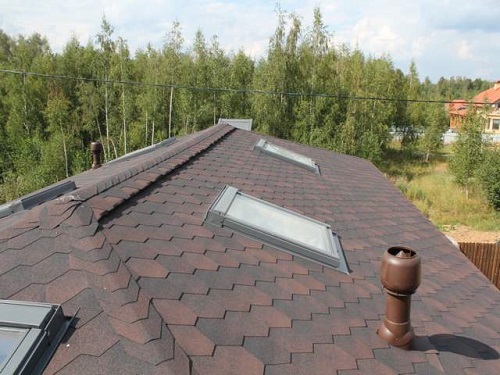
Taking into account all of the above, the value of the angle of inclination of the roof is calculated, focusing on the range from 9 to 60 degrees. Designers usually make the appropriate calculations and usually settle on values that are between 20 degrees and 45.
What is attractive about such an angle of inclination of the roof? The fact that you can use any roofing material - metal tiles, corrugated board, slate, etc. However, each finishing material has its own requirements, which are taken into account when designing a roof structure.
If you chose rolled materials as a roof, then when laying in 2 layers of material, the angle of inclination of the roof should be up to 15, and with three-layer laying - from 2 to 5 degrees.
- The use of welded materials is most suitable when the roof has a slope of 0-25%. When the slope is 0-10%, then the material must be laid in three layers. If the angle of inclination is in the range of 10-25%, one layer can be dispensed with, but the material must be sprinkled.
- Asbestos-cement corrugated sheets (slate) cover roofs with a roof slope of up to 28%.
- Tiles are used when the roof has a slope of at least 33%.
- Steel coating is laid on the roof with a slope angle of less than 29%.
The consumption of material directly depends on the slope of the roof. The larger it is, the greater the consumption of finishing material. As a result, a flat roof will cost less in this regard than a 45-degree roof.
If you know the slope of the roof, then it is not difficult to calculate the amount of material needed. The same can be said about the height of the roof structure.
Let's dwell on each concrete form roofing.
After calculating the angle of inclination of a shed roof, you just need to raise one wall to the desired level, which will provide the calculated value of the angle of inclination.
Roofing from a metal tile
Compared to other roofing materials, metal roofing has a considerable weight. Therefore, when constructing a roof structure using such a finishing coating, one should take into account all the nuances and try to build it so that it has a minimum roof slope angle.
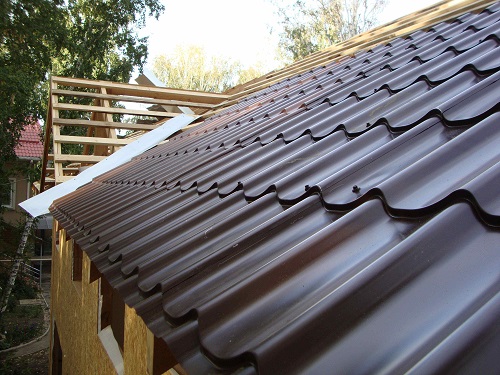
This issue deserves special attention in areas with very strong winds. As you know, the load from the wind has a strong and negative effect on the roof. The calculation of the roof structure in this case must be done especially carefully. When the angle of inclination of the roof is large, "bloating" of the roof can occur, which will entail an increase in load, which will affect the entire structure. In turn, this can lead to premature destruction of the roof.
Roofs that are covered with metal tiles must have a minimum slope angle of 22 degrees. Empirical evidence suggests that due to this indicator, moisture is prevented from accumulating at the joints of the roofing. They are protected from unwanted seepage of water in the form of melted snow or rain.
Important! Minimum slope roofs, when there is such a need, can be at least 14 degrees. If soft tiles are used as a coating, then the minimum value is reduced to 11 degrees. In this case, it would be correct to arrange an additional continuous crate.
Roofing from corrugated board
It is known about corrugated board that it takes the place of one of the most popular roofing materials. Everyone knows its advantages in the form of low weight and ease of installation. Mounting profiled sheets on the roof is not difficult.
Important! It should be noted that when installing such a roof, the requirements for minimum angle roof slopes such - more than 12 degrees (should see the manufacturer's recommendations).
Roofing using rolled "soft" materials
When the roof is made of soft types of roofing, then we are talking about roofing material, ondulin, polymer (membrane) roof coverings. When deciding how to calculate the angle of the roof, the following is taken into account:
- The number of covering layers. Depending on them, the angle of inclination of the roof structure can be from 2 to 15 degrees.
- When covering in 2 layers, it would be good to stop at a roof slope of 15 degrees. For a three-layer, it is quite enough to have a slope within 2-5 degrees.
- Membrane coatings, which are optimal for any type of roof, including the most complex in its geometry, are placed on roofs with a slope of 2-5 degrees.
Without a doubt, the angle of the roof will be chosen by the owner of the building. He must take into account that the roof is designed for temporary and permanent loads. Temporary includes precipitation and its weight. These include the wind, which exerts pressure on the roof structure and directly on the finish coat. When constant loads are mentioned, we are talking about the weight of the roof structure itself and the material of the finishing coating.
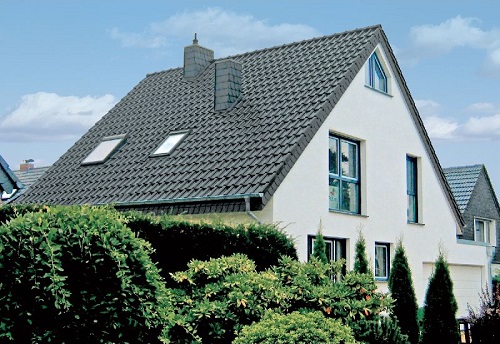
Such a structural element of the roof as a lathing depends on the slope of the roof - its type, pitch and design. For example, the lower the angle of inclination, the shorter the sheathing step in the roofing system should be. The minimum slope of the roof provides for a crate step, which is 35-45 centimeters.
One of the main issues is the question of the amount of material for the finish coating, which must be calculated and purchased. Here one can see such a trend - a larger slope of the roof requires more material consumption.
I would like to offer some practical tips that will be useful when choosing material for the roof:
- with a slight roof slope (less than 10 degrees), the roof can be covered with a material containing stone chips or gravel (thickness 5 mm for crumbs and 15 mm for gravel).
- when the angle of the roof slope is more than 10 degrees, then a basic bitumen waterproofing device will be required. In the case of roll materials, additional protection must be applied. Such a coating, as a rule, is a coloring.
- roofing with roofing material such as corrugated board or asbestos-cement sheets provides for sealing butt joints. The joints in this case are double.
We calculate the angle of inclination of the roof
The calculation of the angle of inclination of the roof depends on the height of the ridge. What height the roof will be in the ridge depends on the functional purpose of the attic space.
When a full-fledged attic room is made from the attic, the angle of inclination is calculated as follows:
For example, the end of the roof (gable width) is 6 meters. This figure is divided in half (6:2=3). The height of the roof in the ridge is always taken as standard 1.8 meters.
Sin A=a/b=3/1.8=1.67
Using the Bradis table, an approximate value is found, which has a roof slope angle with a value of Sin A \u003d 1.67 - this value is in the range of 58-59 degrees. You can stop at the maximum value of 60 degrees, which will become our desired angle of inclination of the roof slope.
You may be interested in: Stretch ceilings Zaporozhye above the clouds Zaporozhye Stretch ceiling.









